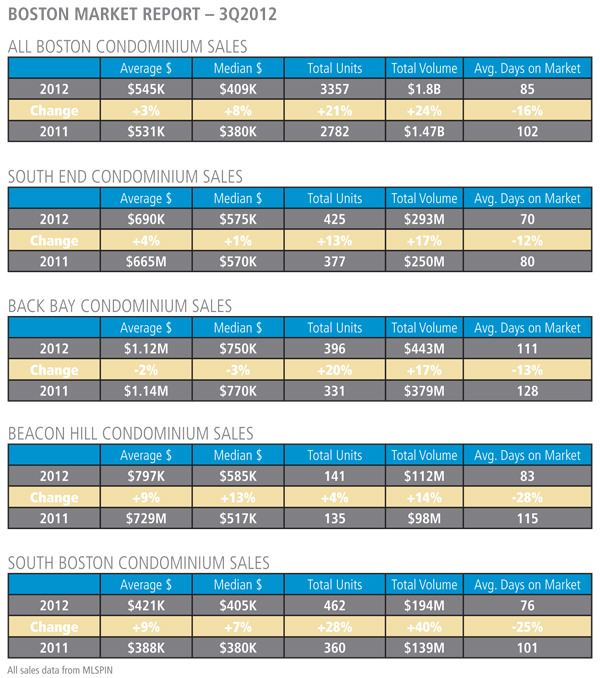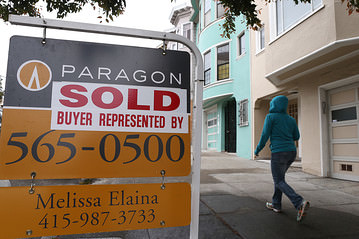Regionally, existing-home sales in the Northeast fell 6.3 percent to an annual level of 590,000 in September but are 7.3 percent above September 2011. The median price in the Northeast was $238,700, up 4.1 percent from a year ago. (see post below)
So locally, which for me is Boston and Provincetown, sales are way up, prices are mixed, and inventory is way down. Quite contrary to regional and national figures. Go figure!
One of my favorites from AGBeat blog, Tara Steele posts her regional and national analysis below.
According to the National Association of Realtors (NAR), September existing-home sales dropped 1.7 percent as inventory levels continue to tighten, also reporting that the median home price jumped up, the first time since November 2005 to May 2006 that prices rose for seven months consecutively.
Existing home sales may have dipped slightly, but are up 11.0 percent from September 2011. The national median existing-home price hit $183,900, up 11.3 percent from September 2011.
Dr. Lawrence Yun, NAR chief economist, said the market trend is up. “Despite occasional month-to-month setbacks, we’re experiencing a genuine recovery,” he said. “More people are attempting to buy homes than are able to qualify for mortgages, and recent price increases are not deterring buyer interest. Rather, inventory shortages are limiting sales, notably in parts of the West.”
Housing inventory and distressed sales
According to Freddie Mac, the national average commitment rate for a 30-year, conventional, fixed-rate mortgage fell to a record low 3.47 percent in September from 3.60 percent in August; the rate was 4.11 percent in September 2011.
Distressed homes accounted for 24.0 percent of sales in September (13.0 percent were foreclosures and 11.0 percent were short sales), up from 22 percent in August; they were 30 percent in September 2011. Foreclosures sold for an average discount of 21 percent below market value in August, while short sales were discounted 13 percent.
Total housing inventory at the end September fell 3.3 percent, representing a 5.9-month supply at the current sales pace, down from a 6.0-month supply in August. Listed inventory is 20.0 percent below a year ago when there was an 8.1-month supply.
“The shrinkage in housing supply is supporting ongoing price growth, a pattern that could accelerate unless home builders robustly ramp up production,” Dr. Yun said.
Median time on market down 30%
The median time on market was 70 days in September, unchanged from August, but down 30.7 percent from 101 days in September 2011. Fully 32.0 percent of homes sold in September were on the market for less than a month, while 19 percent were on the market for six months or longer.
NAR President Moe Veissi said some buyers who could easily afford a mortgage can’t assume they’ll get one. “Home buyers need to be more focused on the mortgage process in the current environment where lenders and banking regulators are being risk averse,” he said, recommending that buyers shop for competitive mortgage terms.
First time buyers coming back
First-time buyers accounted for 32.0 percent of purchasers in September, compared with 31.0 percent in August; they were 32.0 percent in September 2011.
All-cash sales were at 28 percent of transactions in September, up from 27 percent in August; they were 30 percent in September 2011. Investors, who account for most cash sales, purchased 18 percent of homes in September, unchanged from August; they were 19 percent in September 2011.
Single-family home sales declined 1.9 percent to a seasonally adjusted annual rate of 4.21 million in September from 4.29 million in August, but are 10.8 percent higher than the 3.80 million-unit level in September 2011. The median existing single-family home price was $184,300 in September, up 11.4 percent from a year ago.
Existing condominium and co-op sales were unchanged at a seasonally adjusted annual rate of 540,000 in September, but are 12.5 percent above the 480,000-unit pace a year ago. The median existing condo price was $181,000 in September, which is 10.0 percent higher than September 2011.
Regional performance varied
Regionally, existing-home sales in the Northeast fell 6.3 percent to an annual level of 590,000 in September but are 7.3 percent above September 2011. The median price in the Northeast was $238,700, up 4.1 percent from a year ago.
Existing-home sales in the Midwest slipped 0.9 percent in September to a pace of 1.10 million but are 19.6 percent higher than a year ago. The median price in the Midwest was $145,200, up 7.0 percent from September 2011.
In the South, existing-home sales increased 0.5 percent to an annual level of 1.93 million in September and are 14.2 percent above September 2011. The median price in the region was $163,600, up 13.1 percent from a year ago.
Existing-home sales in the West fell 3.4 percent to an annual pace of 1.13 million in September but are 0.9 percent above a year ago. With continuing inventory shortages in the region, the median price in the West was $246,300, which is 18.4 percent higher than September 2011.







